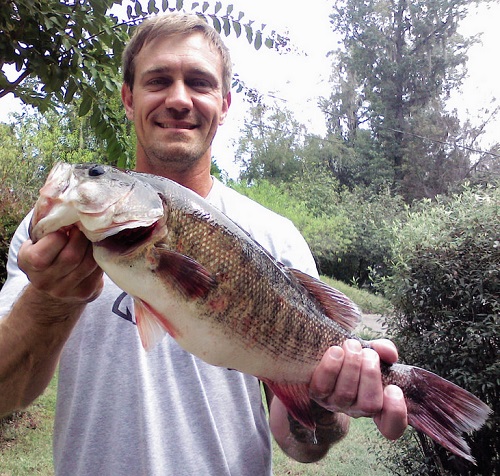 Stewart Mayeaux, 41, of Marianna, enjoyed the thrill of seeing a 4-pound, 14-ounce shoal bass hit his lure on Sept. 19 and knowing he had a possible state record. Mayeaux, who moved from Louisiana five years ago, had read on the MyFWC.com website about several shoal bass records having been caught recently. So he knew it was an achievable goal and had been actively going out most mornings, hoping to catch a record shoal bass.
Stewart Mayeaux, 41, of Marianna, enjoyed the thrill of seeing a 4-pound, 14-ounce shoal bass hit his lure on Sept. 19 and knowing he had a possible state record. Mayeaux, who moved from Louisiana five years ago, had read on the MyFWC.com website about several shoal bass records having been caught recently. So he knew it was an achievable goal and had been actively going out most mornings, hoping to catch a record shoal bass.
When the fish hit, at 8 a.m. Saturday morning, it dove for the bottom, trying to rub the treble-hook loose. After a nice fight, Mayeaux reeled her in, called the Florida Fish and Wildlife Conservation Commission (FWC) and placed her in an aerated tub until fisheries biologist Chris Paxton arrived to verify the species and weigh it on certified scales.

The bass was 20.9-inches long, with a girth of 13.6 inches. The certified weight of 4.85 pounds broke the previous record, which was held jointly by Tucker Martin and Jamie Coleman, who caught 4.49- and 4.50-pound shoal bass, respectively, during March of this year. A state record under five pounds, must beat the previous record by ¼ ounce, so whereas Martin and Coleman shared the record, Mayeaux’s new record stands alone.
Mayeaux complimented Paxton for his knowledge of shoal bass and for explaining some of their unique habitat needs to him. Shoal bass thrive in the Apalachicola water system, including the Chattahoochee and Flint Rivers of Alabama and Georgia, and the Chipola River in Florida. Once thought to be redeye bass, they were determined to be a separate species in 1999.
Due to their limited habitat range, the FWC identifies them as a “species of greatest conservation need,” according to biologist Katie Woodside, who recently published a chapter in the book “Black Bass Diversity-Multidisciplinary Science for Conservation.” Shoal bass are well-adapted to river life and are part of the same group of black basses as largemouth bass, spotted bass and the newly identified Choctaw bass.
The FWC is proposing new rules to continue to protect all of these species and to ensure their “optimum-sustained use” (see MyFWC.com/Fishing and click on “Speak out on bass rules” to learn more and comment). If the proposed rule passes in February 2016, after July 1, 2016, shoal bass will have a protected conservation area that is restricted to catch-and-release only from Peacock Bridge to Johnny Boy Landing on the Chipola River.
Elsewhere, in the Suwannee River and in its tributaries, and areas north and west of there, the combined bag limit of five black bass, with a minimum length of 12 inches for shoal, Choctaw, Suwannee and spotted bass, would remain the same. However, a new maximum of only one black bass 16 inches in total length or longer would be added, to help sustain this unique sport fishery.
In a recent FWC Freshwater Fisheries blog posted on FloridaSportsman.com, FWC biologist Ted Alfermann was prescient when he said, “Now’s the time to catch a state-record shoal bass. At the very least, anglers will come away having fished one of the most picturesque rivers in the state and gain an appreciation for one of the most unique fish in the entire Southeastern United States.”
